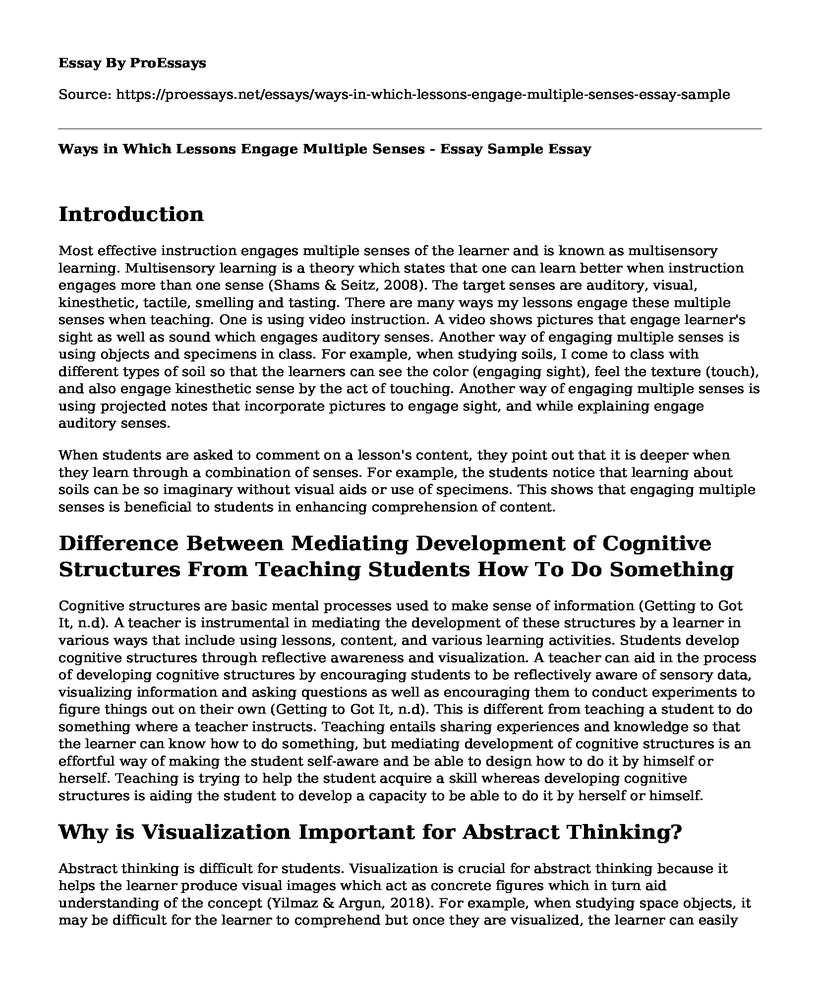Introduction
Most effective instruction engages multiple senses of the learner and is known as multisensory learning. Multisensory learning is a theory which states that one can learn better when instruction engages more than one sense (Shams & Seitz, 2008). The target senses are auditory, visual, kinesthetic, tactile, smelling and tasting. There are many ways my lessons engage these multiple senses when teaching. One is using video instruction. A video shows pictures that engage learner's sight as well as sound which engages auditory senses. Another way of engaging multiple senses is using objects and specimens in class. For example, when studying soils, I come to class with different types of soil so that the learners can see the color (engaging sight), feel the texture (touch), and also engage kinesthetic sense by the act of touching. Another way of engaging multiple senses is using projected notes that incorporate pictures to engage sight, and while explaining engage auditory senses.
When students are asked to comment on a lesson's content, they point out that it is deeper when they learn through a combination of senses. For example, the students notice that learning about soils can be so imaginary without visual aids or use of specimens. This shows that engaging multiple senses is beneficial to students in enhancing comprehension of content.
Difference Between Mediating Development of Cognitive Structures From Teaching Students How To Do Something
Cognitive structures are basic mental processes used to make sense of information (Getting to Got It, n.d). A teacher is instrumental in mediating the development of these structures by a learner in various ways that include using lessons, content, and various learning activities. Students develop cognitive structures through reflective awareness and visualization. A teacher can aid in the process of developing cognitive structures by encouraging students to be reflectively aware of sensory data, visualizing information and asking questions as well as encouraging them to conduct experiments to figure things out on their own (Getting to Got It, n.d). This is different from teaching a student to do something where a teacher instructs. Teaching entails sharing experiences and knowledge so that the learner can know how to do something, but mediating development of cognitive structures is an effortful way of making the student self-aware and be able to design how to do it by himself or herself. Teaching is trying to help the student acquire a skill whereas developing cognitive structures is aiding the student to develop a capacity to be able to do it by herself or himself.
Why is Visualization Important for Abstract Thinking?
Abstract thinking is difficult for students. Visualization is crucial for abstract thinking because it helps the learner produce visual images which act as concrete figures which in turn aid understanding of the concept (Yilmaz & Argun, 2018). For example, when studying space objects, it may be difficult for the learner to comprehend but once they are visualized, the learner can easily follow the concept and relationships because the object has been presented in a concrete image. In mathematics, for example, a teacher can ask the students to imagine of a real-world mathematical problem such as going to a shop, giving out 1000 for goods worth 300 and getting a change of 700. Such an example helps the learner understand the concept of subtraction and how it makes sense in the real world.
Instructional Implications for Students Being Unaware of Location, Distance, Direction, and Perspective
Students who are unaware of location, distance, direction and perspective call for a teacher to employ visualization in the teaching style, use teaching aids that help students learn these aspects such as compass direction chart and maps. The teacher has to use more images and objects to illustrate points because the students cannot develop abstract thinking if they are not aware of location or distance, for instance. These characteristics of spatial orientation determine how accurate or inaccurate a student can collect information from a specified area. For instance, in a research study, being unaware of distance and direction can lead to collecting random information from an area without being objective. Likewise, being unaware of perspective can impair a student's ability to separate facts from opinions to reach sound and evidence-based conclusions.
References
Getting to Got It. (n.d). Helping Struggling Students Learn How to Learn [PowerPoint Slides]
Shams, L., & Seitz, A. R. (2008). Benefits of multisensory learning. Trends in Cognitive Sciences, 12(11), 411-417.
Yilmaz, R., & Argun, Z. (2018). Role of Visualization in Mathematical Abstraction: The Case of Congruence Concept. International Journal of Education in Mathematics, Science and Technology, 6(1), 41-57.
Cite this page
Ways in Which Lessons Engage Multiple Senses - Essay Sample. (2022, Nov 15). Retrieved from https://proessays.net/essays/ways-in-which-lessons-engage-multiple-senses-essay-sample
If you are the original author of this essay and no longer wish to have it published on the ProEssays website, please click below to request its removal:
- Mother Tongue by Amy Tan Review
- Student, Family, Poverty, and Schooling Essay
- Why Being Bilingual Makes the Brain Stronger Essay
- Paper Example on Gentrification & Its Impact on US Neighborhoods
- Essay Example on Learning Oral Language: Tips & Guidelines for Kids
- Paper on Grandma and Me: Baking Our Way to Connection
- Essay Sample on College Degree: Essential for Successful Career & Adult Life







